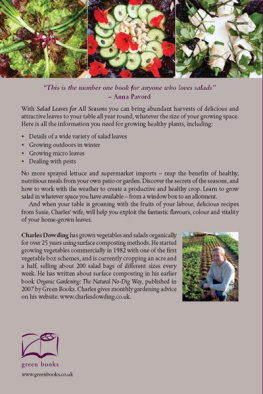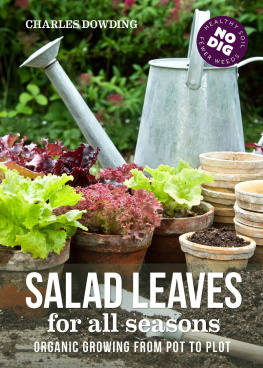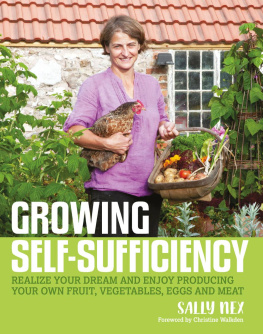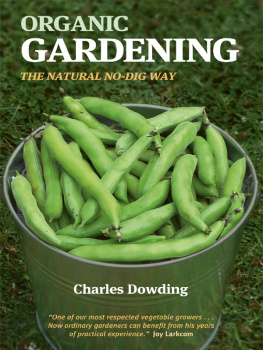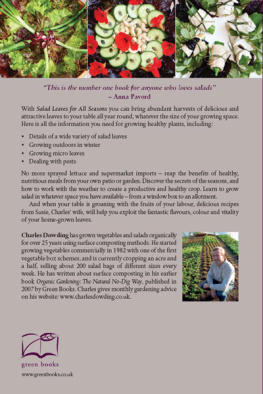Salad Leaves
for All Seasons
Salad Leaves
for All Seasons
ORGANIC GROWING FROM POT TO PLOT

Charles Dowding
With drawings by Jennifer Johnson

First published in 2008
by Green Books Ltd
Foxhole, Dartington,
Totnes, Devon TQ9 6EB
Reprinted 2008
First produced in ebook formats 2010
Text and photographs Charles Dowding 2008-2010
Illustrations Jennifer Johnson
All rights reserved. No part of this book may be transmitted
or reproduced in any form by any means without
permission in writing from the publisher.
Charles Dowding has asserted his moral right
to be identified as the author of this book.
British Library Cataloguing in Publication Data
available on request
Print ISBN 978 1 900322 20 1
PDF format ISBN 978 1 907448 02 7
ePub format ISBN 978 1 907448 03 4
For Susie
Acknowledgements
To all the people who have helped me grow vegetables over the years, especially:
Victor Crutchley, David Sanders and Bepp, Lisa, Brian, Anne, Pippa Beckett, David Godfrey, Wallee McDonnell, Susie Corbett, Bill Craster, Sara Frears, Paul and Ulli from Germany, Hilda Denham, Nicky Hembridge, Vicky Matthews, Finny Fox-Davies, Kate Plowman, Greg Morter, Nicole Leathley, Heather Mora, Emily Evans, Geoff Branson, Rosie Stott and Alex Simon.
Introduction

Since starting vegetable growing in 1981, I have become more and more fascinated by salad. Lettuce was one of the first crops in 1983, from my newly created acre and a half of raised beds in the old farm orchard. In May and June of that year I sold many dozens of butterhead lettuce hearts, some in the village, where a surprised neighbour commented that there was enough flavour for her not to need any mayonnaise!
That set me wondering; where had the flavour gone in other lettuce? All I had done was to grow them in honest soil to organic standards. Over the next few years, lettuce became one of my bestsellers and also, luckily, one of the few slightly profitable crops to grow - partly because it matured so quickly, and partly because it always sold so well, in spite of the little grey slugs lurking inside many hearts (as they do). But in those days, other salad leaves were not in demand and lambs lettuce was almost the only different kind I grew, mostly to sell in March and April.
Moving to France in 1991 helped me to explore some new possibilities. Oddly enough the kitchen garden at our small farm grew purslane as one of its main summer weeds, far more than we could eat. Endives were often sold in local markets and pretty oak-leaved lettuce as well, but even there the locals phrase une salade meant lettuce or endive heart only. There was no interest in loose leaves of rocket which after all came from Italy, or in oriental leaves from even farther away.
So my interest in the great potential of salad leaves lay dormant for a while. After returning to Britain, it was a request from Bill the Butcher in Bruton to create some bags of mixed leaves that opened my eyes to the possibilities for anyone with some soil, compost, a bit of spare room in the garden and a spirit of adventure. Since then I have enjoyed experimenting with different seeds, sowing dates, picking methods and growing media to discover new flavours, shapes and colours at all different times of year.
Salad bags from Lower Farm are now sold in many outlets within about four miles, enough distance to provide enough customers for everything I can grow. Picking takes much more time than growing and is a demanding job, bent over in the cool of the dawn; two of us gather leaves before and just after breakfast then mix, wash and pack them immediately so that people can eat them that day or pubs can serve them for lunch. Customer feedback is enthusiastic, often emphasising the leaves flavour and keeping ability which is because they are healthy and alive.
In this book I offer you the information needed to grow and harvest leaves of a similar quality and variety.
The Conjurors Hat
Salad leaves are one of the quickest and easiest vegetables you can grow. More than that, plants that are well looked after will provide long successions of harvests, without having to repeatedly sow or plant again. How to continually crop the same plants and give them a surprisingly long life-a main theme of this book-is explained in Part One. New leaves just keep appearing - it is almost magical.
Another key theme in the book is growing in small spaces and containers, which can be impressively productive. You may also find yourself appreciating the growing beauty of your range of salad plants, as much as their abundant contributions to the table.
The leaves you pick will also be full of seasonal characteristics, reflecting how different salads give of their best at particular times of year. Appreciating this calendar of salad seasons, explained in Part Two, will help towards more success in growing healthy plants. In Part Three I offer a tour of the great range of salad possibilities, and all necessary information on how to obtain the best from them. Lastly, in Part Four there is an explanation of how to use covered spaces to extend the season of growth and to ensure a steady supply of leaves for much of the winter, as well as earlier outdoor harvests in the spring.
Charles Dowding
Lower Farm
March 2008
Part One
GROWING LEAVES
Chapter 1
High Yields, Small Spaces, Special Methods
Learning new tricks

You do not need a large garden to grow good amounts of leaves. Small beds or containers can produce surprisingly large harvests, especially if they are in full light. Whatever the size of your growing area, the important thing is to make the most of it.
THE KEYS TO SUCCESS
Many salad plants can be long-lived when they are correctly chosen for the season and well tended. This is a key aspect of successful growing, enabling you to enjoy high production from small areas. Which plants are grown and how they are picked is as important as your general sowing and growing techniques (see for more details) and careful choosing and tending of plants really can make even containers and window boxes capable of producing enough leaves to be a good asset to the table.
Sowing at the right moment also makes an important difference. The season, the moon and the weather all play a part and becoming more aware of their changes will bring you extra knowledge and health, not least from having more leaves to eat.
FIRST STEPS
Keep your initial purchases small and simple. Catalogues and shops are full of expensive accessories that are not strictly necessary. The main things you will need are seed and/or plants, a container or bed to grow them in, some good compost, a watering-can and, above all, sufficient time to tend your plants on a regular basis. Once a growing space is set up, the main work is picking leaves.
Start in a small way, but also experiment with lots of different salad plants to see which ones grow best for you and provide leaves which you enjoy eating. Soon you will get the hang of managing an interesting range of plants at different times of year to keep those healthy harvests coming.
Next page
